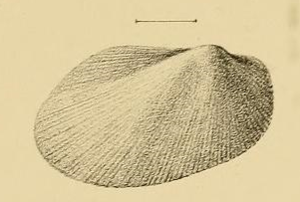Bentharca
| Bentharca | ||||||||||||
|---|---|---|---|---|---|---|---|---|---|---|---|---|

|
||||||||||||
| Systematics | ||||||||||||
|
||||||||||||
| Scientific name | ||||||||||||
| Bentharca | ||||||||||||
| Verrill & Bush , 1898 |
Bentharca is a shell - genus from the family of ark shells (Arcidae).
features
The housings, which can be equally or slightly differently folded, are roughly elongated-rhombic to roughly wedge-shaped in outline. The right flap can also be slightly smaller than the left flap. The maximum length is 10 millimeters. They are significantly longer than they are tall and comparatively flattened; H. have a small thickness when looking at the closed flaps from above. The rear part of the housing is greatly elongated, the vertebra is always much closer to the front end, usually even in the front quarter. The vertebrae are small and not very prominent. The dorsal margin is long and merges at an angle into the anterior and posterior margins; the transition at the front end is more angled. Because the front end slopes very flat towards the ventral edge, the rear of the housing is significantly higher than in the front part. In the anterior ventral margin there is a clear indentation for the byssus ; the two flaps also gape when the housing is closed. There is no back in the rear part of the housing that starts from the vertebra and extends to the angle between the posterior and ventral edge. A back that initially attaches to the vertebra may be present; it flattens out quickly and is no longer noticeable before halfway to the rear edge. The dorsal field is narrow and flat. The inner edge of the case is smooth.
The lock is taxodont, the lock edge is long and straight. The ligament extends over the posterior dorsal margin, more rarely it extends between the vertebrae. The lock's teeth are very small and sit in two groups on the narrow lock plate, separated from a tooth-free part of the lock plate. In the front group the teeth are inclined to the lock plate (upper ends tilted outwards), in the rear they are approximately parallel to the dorsal edge.
The skin is thin but not translucent. The ornamentation consists of concentric, widely spaced low ribs, which are interrupted by radial rows of bristles. The periostracum is drawn out to dark brown bristles on the rear housing field.
There are two sphincter muscles of unequal size; the anterior sphincter is smaller than the posterior sphincter. The attachments of the muscles are only indistinct.
Similar genera
The genus Bentharca is very similar to the genus Bathyarca ; Bentharca was therefore already understood as a subgenus of Bathyarca . The housing of the Bentharca species is more elongated to the rear than that of Bathyarca ; it is rather rhombic and rounded-angular. Bathyarca has a similar case shape, but the case is better rounded. In Bathyarca there is no back ( Carina ) starting from the vertebra , not even indicated. In the case of Bentharca , the housing is usually much more finely ribbed in the radial direction. On the lock plate, the rear teeth are very slanted or mostly almost parallel to the lock edge.
Geographical distribution and habitat
The species of the genus Bentharca have been found in the Atlantic , Indian and Pacific Oceans . The few species live in deeper water (from approx. 400 meters water depth) to over 4000 meters water depth. They live there with byssus threads attached to a hard substrate.
Taxonomy
The taxon was first described in 1898 by Addison Emery Verrill and Katherine Bush . The type species is Macrodon asperula Dall, 1881. The World Register of Marine Species assigns four species to the genus:
-
Bentharca Verrill & Bush , 1898
- Bentharca asperula (Dall, 1881)
- Bentharca avellanaria (Melvill & Standen, 1907)
- Bentharca hawaiensis Dall, Bartsch & Rehder, 1938
- † Bentharca waitakarensis Eagle, 2000 ( Altonian , corresponds roughly to Burdigalium , Miocene )
In the past, Bentharca was viewed by some authors as a sub-genus of Bathyarca (Kilias).
supporting documents
literature
- Markus Huber: Compendium of Bivalves. 901 S., Hackenheim, ConchBooks, 2010 ISBN 978-3-939767-28-2
- Rudolf Kilias: Lexicon marine mussels and snails. 2nd edition, 340 p., Verlag Eugen Ulmer, Stuttgart 1997 ISBN 3-8001-7332-8 (p. 46)
- Raymond Cecil Moore (Ed.): Treatise on invertebrate paleontology. Mollusca, 6, Bivalvia 1. XXXVIII, 489 pp., New York, 1969 (pp. N254).
- Fritz Nordsieck : The European sea shells (Bivalvia). From the Arctic Ocean to Cape Verde, the Mediterranean Sea and the Black Sea. 256 p., Gustav Fischer Verlag, Stuttgart 1969 (p. 23)
Individual evidence
- ↑ Addison E. Verrill, Katherine J. Bush: Revision of the deep-water Mollusca of the Atlantic coast of North America, with descriptions of new genera and species. Part I. - Bivalvia. Proceedings of the United States National Museum, 20: 775-932, 1898 Online at www.biodiversitylibrary.org .
- ^ World Register of Marine Species: Bentharca Verill & Bush, 1898
- ↑ James Cosmo Melvill, Robert Standen: The Mollusca of the Persian Gulf, Gulf of Oman, and Arabian Sea, as evidenced mainly through the Collections of Mr. FW Townsend, 1893-1906; with descriptions of new species. Part. II. Pelecypoda. Proceedings of the Zoological Society of London, 1906 (May-December): 783-848, London 1907 Online at www.biodiversitylibrary.org (p. 797)
- ^ Michael K. Eagle: Six new fossil bivalves from the Early Miocene of Auckland and Northland, New Zealand. Records of the Auckland Museum, 36: 141-168, 2000
annotation
- ↑ This species belongs to the genus Asperarca because of its ornamentation . Eagle (2000) treated Asperarca as a synonym of Bentharca , i.e. H. did not distinguish between species of the genus Asperarca and Bentharca .